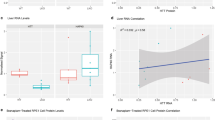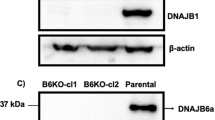Abstract
Huntington disease (HD) is associated with the expansion of a polyglutamine tract, greater than 35 repeats, in the HD gene product, huntingtin. Here we describe a novel huntingtin interacting protein, HIP1, which co-localizes with huntingtin and shares sequence homology and biochemical characteristics with Sla2p, a protein essential for function of the cytoskeleton in Saccharomyces cerevisiae. The huntingtin–HIP1 interaction is restricted to the brain and is inversely correlated to the polyglutamine length in huntingtin. This provides the first molecular link between huntingtin and the neuronal cytoskeleton and suggests that, in HD, loss of normal huntingtin–HIP1 interaction may contribute to a defect in membrane-cytoskeletal integrity in the brain.
This is a preview of subscription content, access via your institution
Access options
Subscribe to this journal
Receive 12 print issues and online access
$209.00 per year
only $17.42 per issue
Buy this article
- Purchase on Springer Link
- Instant access to full article PDF
Prices may be subject to local taxes which are calculated during checkout
Similar content being viewed by others
References
Ross, C.A. When more is less: Pathogenesis of glutamine repeat neurodegenerative diseases. Neuron 15, 493–496 (1995).
Zoghbi, H.Y. The expanding world of ataxins. Nature Genet. 14, 237–239 (1996).
Hayden, M.R. Huntington's chorea. 59–75, (Springer-Verlag, London, Berlin, 1981).
Harper, P.S., Huntington's chorea. 31–72 (W.B. Saunders, London, 1991).
A novel gene containing a trinucleotide repeat that is expanded and unstable on Huntington's disease chromosomes. Cell 72, 971–983 (1993).
Kremer, H.P.H. et al. A worldwide study of the Huntington's disease mutation: The sensitivity and specificity of measuring CAG repeats. New. Engl. J. Med. 330, 1401–1406 (1994).
Andrew, S.E. et al. The relationship between trinucleotide repeat (CAG) length and clinical features of Huntington disease. Nature Genet. 4, 398–403 (1993).
Duyao, M. et al. Trinucleotide repeat length instability in Huntington disease. Nature Genet. 4, 387–392 (1993).
Snell, R.G. et al. Relationship between trinucleotide repeat expansion and phenotypic variation in Huntington's disease. Nature Genet. 4, 393–397 (1993).
Lin, B.-Y. et al. Differential 3′ polyadenylation of the Huntington disease gene results in two mRNA species with variable tissue expression. Hum. Mol. Genet. 2, 1541–1545 (1993).
Schilling, G. et al. Expression of the Huntington's disease (IT15) protein product in HD patients. Hum. Mol. Genet. 5, 1365–1371 (1995).
Sharp, A. et al. Widespread expression of Huntington's disease gene (IT-15) protein product. Neuron 14, 1065–1074 (1995).
Aronin, N. et al. CAG Expansion affects the expression of mutant huntingtin in the huntington's disease brain. Neuron 15, 1193–1201 (1995).
Vonsattel, J.P. et al. Neuropathological classification of Huntington's disease. J. Neuropathol. Exp. Neurol. 44, 559–577 (1985).
Servadio, A. et al. Expression analysis of the ataxin-1 protein in tissues from normal and spinocerebellar ataxia type 1 individuals. Nature Genet. 10, 94–98 (1995).
DiFiglia, M. et al. Huntingtin is a cytoplasmic protein associated with vesicles in human and rat brain neurons. Neuron 14, 1075–1141 (1995).
Telenius, H. et al. Molecular analysis of juvenile Huntington disease: the major influence on (CAG)n repeat length is the sex of the affected parent. Hum. Mol. Genet. 2, 1535–1540 (1993).
Chien, C.-T., Bartel, P.L., Sternglanz, R. & Fields, S. The two-hybrid system: A method to identify and clone genes for proteins that interact with a protein of interest. Proc. Natl. Acad. Sci. USA. 88, 9578–9582 (1991).
Fields, S. & Song, O.-K. A novel genetic system to detect protein-protein interacts. Nature 340, 245–246 (1993).
Holtzman, D.A., Yang, S. & Drubin, D.G. Synthetic-lethal interactions identify two novel genes, SLA1 and SLA2, that control membrane cytoskeleton assembly in Saccharomyces cerevisiae. J. Cell Biol. 122, 635–644 (1993).
Kalchman, M.A. et al. Huntingtin is ubiquitinated and interacts with a specific ubiquitin conjugated enzyme. J. Biol. Chem. 271, 19385–19394 (1996).
Li, X.-J. et al. A huntingtin-associated protein enriched in brain with implications for pathology. Nature 378, 398–402 (1995).
Na, S., Hincapie, M., McCusker, J.H. & Haber, J.E. MOP2 (SLA2) affects the abundance of the plasma membrane H+-ATPase of Saccharomyces cerevisiae. J. Biol. Chem. 270, 375–443 (1995).
Raths, S., Rohrer, J., Crausaz, F. & Riezman, H. end3 and end4: Two mutants defective in receptor-mediated and fluid-phase endocytosis in Saccharomyces cervisiae. J. Cell Biol. 120, 55–65 (1993).
Pearlman, J.A., Powaser, P.A., Caskey, C.T. Troponin T is capable of binding dystrophin via a leucine zipper. FEBS Letters 354, 183–186 (1994).
John, M., Briand, J.P., Granger-Schnarr, M. & Schnarr, M. Two pairs of oppositely charged amino acids from Jun and Fos confer heterodimerization to GCN4 leucine zipper. J. Biol. Chem. 269, 16247–16253 (1994).
Rees, D.J., Ades, S.E., Singer, S.J. & Hynes, R.O. Sequence and domain structure of talin. Nature 347, 18–63 (1990).
Nasir, J. et al. Targeted disruption of the Huntington's disease gene results in embryonic lethality and behavioral and morphological changes in heterozygotes. Cell 81, 811–823 (1995).
Hodgson, J.G. et al. Human huntingtin derived from YAC transgenes compensates for loss of murine huntingtin by rescue of the embryonic lethal phenotype. Hum. Mol. Genet. 5, 1875–1885 (1996).
Rabizadeh, S. et al. Mutations associated with amyotrophic lateral sclerosis convert superoxide dismutase from an antiapoptotic gene to a proapoptotic gene: studies in yeast and neural cells. Proc Natl. Acad. Sci. USA. 92, 3024–3028 (1995).
Morrow, D.M., Tagle, D.A., Shiloh, Y., Collins, F.S. & Hieter, P. TEL1, an S. cerevisiae homologue of the human gene mutated in ataxia telangiectasia, is functionally related to the yeast checkpoint gene MEC1. Cell 82, 831–840 (1995).
Towbin, H., Staehelin, T. & Gordon, J. Electrophoretic transfer of proteins form polyacrylamide gels to nitrocellulose sheets: Procedure and some applications. Proc. Natl. Acad. Sci. USA. 76, 100–104 (1979).
Shull, G.E., Schwartz, A. & Lingrel, J.B. Amino-acid sequence of the catalytic subunit of the (Na+ + K+)ATPase deduced from a complementary DNA. Nature 316, 33–34 (1985).
MacLennan, D.H., Brandl, C.J., Korczak, B. & Green, N.M., Calcium ATPases: contribution of molecular genetics to our understanding of structure and function. Soc. Gen. Phys. Ser. 41, 287–300 (1987).
Brandl, C.J., Green, N.M., Korczak, B. & MacLennan, D.H., Two Ca2+ ATPase genes: homologies and mechanistic implications of deduced amino acid sequences. Cell 44, 597–607 (1986).
Wood, J.D., Harper, P.S. & Jones, A.L. Characteristics of cytosolic and membrane bound forms of huntingtin. Am. J. Hum. Genet. 59, A295(1996).
Wood, J.D., MacMillan, J.C., Harper, P.S., Lowenstein, P.R. & Jones, A.L. Partial characterisation of murine huntingtin and apparent variations in the subcellular localisation of huntingtin in human, mouse and rat brain. Hum. Mol. Genet. 5, 418–487 (1996).
Bhide, P.G. et al. Expression of normal and mutant huntingtin in the developing brain. J. Neurosci. 16, 5523–5535 (1996).
Burke, J.R. et al. Huntingtin and DRPLA proteins selectively interact with the enzyme GAPDH. Nature Med. 2, 347–350 (1996).
Sirover, M.A. Emerging new functions of the glycolytic protein, glyceraldehyde-3-phosphate dehydrogenase, in mammalian cells. Life Sci. 58, 2271–2277 (1996).
Koshy, B. et al. Spinocerebellar ataxia type-1 and spinobulbar muscular atrophy gene products interact with glyceraldehyde-3-phosphate dehydrogenase. Hum. Mol. Genet. 5, 1311–1318 (1996).
Nasir, J., Goldberg, Y.P. & Hayden, M.R. Huntington disease: new insights into the relationship between CAG expansion and disease. Hum. Mol. Genet. 5, 1431–1435 (1996).
Goldberg, Y.P. et al. Cleavage of huntingtin by apopain, a proapoptotic cysteine protease, is modulated by the polyglutamine tract. Nature Genet. 13, 442–449 (1996).
Goldberg, Y. et al. Absence of disease phenotype and intergenerational stability of the CAG repeat in transgenic mice expressing the human Huntington disease transcript. Hum. Mol. Genet. 5, 177–185 (1996).
Durfee, T. et al. The retinoblastoma protein associates with the protein phosphatase type 1 catalystic subunit. Genes & Develop. 7, 555–569 (1993).
Gietz, R.D., Woods, R.A., Manivasakam, P. & Schiestl, R.H. Yeast growth and yeast transformation. in Cell Biology: A Laboratory Manual (eds Spector, D., Goldman, R. & Leinwand, L.) (Cold Spring Harbor Laboratory Press, Cold Spring Harbor, New York, 1996). In press.
Suzuki, T. et al. Regional and cellular presenilin 1 gene expression in human and rat tissues. Biochem. Biophys. Res. Comm. 219, 708–713 (1996).
Lin, B. et al. Differential 3′ polyadenylation of the Huntington disease gene results in two mRNA species with variable tissue expression. Hum. Mol. Genet. 2, 1541–1545 (1993).
Arai, M. & Cohen, J.A. Subcellular localization of the F5 protein to the neuronal membrane-associated cytoskeleton. J. Neurosc. Res. 38, 348–357 (1994).
Wanker, E. et al. HIP-1: A huntingtin interacting protein isolated by the yeast two-hybrid system. Hum. Mol. Genet. 6, 487–495 (1997).
Author information
Authors and Affiliations
Rights and permissions
About this article
Cite this article
Kalchman, M., Koide, H., McCutcheon, K. et al. HIP1, a human homologue of S. cerevisiae Sla2p, interacts with membrane-associated huntingtin in the brain. Nat Genet 16, 44–53 (1997). https://doi.org/10.1038/ng0597-44
Received:
Accepted:
Issue Date:
DOI: https://doi.org/10.1038/ng0597-44
This article is cited by
-
Specific populations of urinary extracellular vesicles and proteins differentiate type 1 primary hyperoxaluria patients without and with nephrocalcinosis or kidney stones
Orphanet Journal of Rare Diseases (2020)
-
Drug repositioning for psychiatric and neurological disorders through a network medicine approach
Translational Psychiatry (2020)
-
Neuronal proteins are novel components of podocyte major processes and their expression in glomerular crescents supports their role in crescent formation
Kidney International (2013)
-
Genome wide gene expression regulation by HIP1 Protein Interactor, HIPPI: Prediction and validation
BMC Genomics (2011)
-
Huntington’s Disease and Group I Metabotropic Glutamate Receptors
Molecular Neurobiology (2011)



